|
||||
|
||||
![]()
|
|
 British Naval Officer in Charge: Wm Reginald Denys Crowther 16.4.1940 - 1.4.1941 |
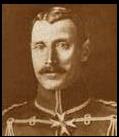 Head of State: King Christian X 14.5.1912 - 20.4.1947 |
 Governor: Carl Aage Hilbert 1936 - 1945 |
![]()
Printer: Danmarks Nationalbank's Bankote Printing Works
(No Imprint),
Local Printer for Overprint
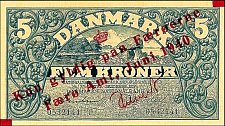 P.1, SB.801 5 Kroner 6.1940 |
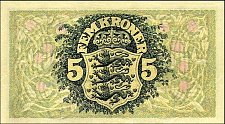 Back |
||
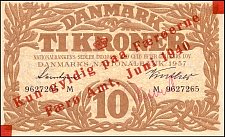 P.2, SB.802a 10 Kroner 6.1940 Hand Signed CL1 |
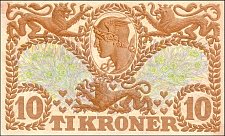 Back |
||
| P.3, SB.802b 10 Kroner 6.1940 Printed Signature | |||
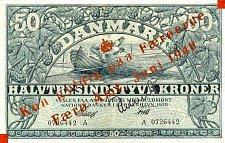 P.4, SB.803 50 Kroner 6.1940 Authentic? |
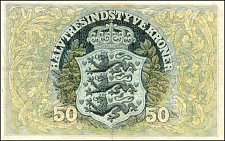 Back |
||
| P.5, SB.804 100 Kroner 6.1940 | |||
| P.6, SB.805 500 Kroner 6.1940 | |||
|
|
|||
| Denmark
fell to the Germans in May 1940 and the Faeroes immediately began
countermeasures to protect themselves from rampant inflation since they
used Danish currency. By authority of the Faero Amt (local administration)
all of the currency on the islands was stamped "Kun gyldig paa Færøerne
Færo Amt, Juni 1940" (Only valid on the Faroes/Faroe County, June
1940). This overstamp is believed to have been used on all currency in the country at the time including both new and used banknotes. The 10 Kroner P.2, SB.802a dated 6.1940 is the banknote most often found today and is usually seen in a high state of preservation. The overprinted notes were intended to be an interim measure until the production of new local note designs could begin. With the ex 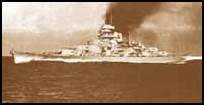 ception
of the 10 Kroner, all of these overprinted issues are rarely seen on the
market and command prices in the thousands of dollars. ception
of the 10 Kroner, all of these overprinted issues are rarely seen on the
market and command prices in the thousands of dollars.On April 4, 1941 Great Britain established a protectorate over the Faroes just in time as the German fleet was spotted nearby. A battle between the German battleship Bismarck and British cruisers took place near the Faroes a few weeks later. A formal protest by the Danish governor was lodged with the British consul over the establishment of the protectorate. The British occupation was generally welcomed with a number of Faroese women marrying British soldiers who then immigrated to England at the end of the war. Some British soldiers also remained in the islands at wars end. The first series of local emergency issues were simple in design, dated October 1, 1940 and comprised 10 and 100 Kroner. They were inscribed FAEROERNE (Local Administration) vertically at the sides. The text signifies that, under emergency decree 32 of October 14, 1940, the Amtsmann (governor) had authorized the notes in place of the currency of the Danish National Bank. Serial numbers flanked the signature of the official of the Faero Amt. The 100 kroner was somewhat more elaborate including a sailing ship and a ram's head upper right. These notes were printed locally in Tórshavn on unwatermarked paper. The second series of emergency local issues were dated November 1940 with an inscription in the center signified that the notes were issued in place of the National Bank series and were restricted in validity to the islands. This series was printed in England by Bradbury, Wilkinson & Co. They remained in use throughout the British occupation and circulated until new Danish banknotes arrived November 1948. _Zacharias_Heinesen_sm.jpg) A
series of local emergency issues have also been reported. They were
identified as having been issued in 1941 by Zacharias Heinesen in Tórshavn
with values of 1, 2, 5, 10 and 25 Øre. In an attempt to determine more
information about them I have written to Zacharias Heinesen, the
renowned artist living in Tórshavn. Since he was born in 1936 if they do
exist, they were probably issued by a relative. Heinesen has been honored
recently by having a number of his paintings displayed on Faroes Islands
postage stamps. More recently, the
backs of the latest series of Faroes
banknotes also depict his landscape paintings. A
series of local emergency issues have also been reported. They were
identified as having been issued in 1941 by Zacharias Heinesen in Tórshavn
with values of 1, 2, 5, 10 and 25 Øre. In an attempt to determine more
information about them I have written to Zacharias Heinesen, the
renowned artist living in Tórshavn. Since he was born in 1936 if they do
exist, they were probably issued by a relative. Heinesen has been honored
recently by having a number of his paintings displayed on Faroes Islands
postage stamps. More recently, the
backs of the latest series of Faroes
banknotes also depict his landscape paintings. |
Faroe INDEX
![]()
FAROE ISLAND LINKS
© Garry Saint,
Esquire 1999-2009